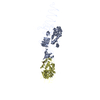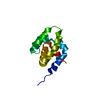+ Open data
Open data
- Basic information
Basic information
| Entry | Database: EMDB / ID: EMD-9332 | |||||||||
|---|---|---|---|---|---|---|---|---|---|---|
| Title | Helical assembly of the CARD9 CARD | |||||||||
 Map data Map data | Helical assembly of the CARD9 CARD | |||||||||
 Sample Sample |
| |||||||||
 Keywords Keywords | CARD / filament / helical assembly / death domain / innate immunity / SIGNALING PROTEIN | |||||||||
| Function / homology |  Function and homology information Function and homology informationregulation of interleukin-2 production / host-mediated modulation of intestinal microbiota composition / CBM complex / antifungal innate immune response / response to peptidoglycan / positive regulation of stress-activated MAPK cascade / CARD domain binding / positive regulation of T-helper 17 type immune response / response to aldosterone / neutrophil mediated immunity ...regulation of interleukin-2 production / host-mediated modulation of intestinal microbiota composition / CBM complex / antifungal innate immune response / response to peptidoglycan / positive regulation of stress-activated MAPK cascade / CARD domain binding / positive regulation of T-helper 17 type immune response / response to aldosterone / neutrophil mediated immunity / positive regulation of cytokine production involved in inflammatory response / positive regulation of innate immune response / positive regulation of granulocyte macrophage colony-stimulating factor production / positive regulation of macrophage cytokine production / response to exogenous dsRNA / response to muramyl dipeptide / positive regulation of interleukin-17 production / immunoglobulin mediated immune response / regulation of immune response / stress-activated MAPK cascade / positive regulation of chemokine production / JNK cascade / signaling adaptor activity / positive regulation of cytokine production / positive regulation of JNK cascade / apoptotic signaling pathway / NOD1/2 Signaling Pathway / : / protein homooligomerization / positive regulation of interleukin-6 production / CLEC7A (Dectin-1) signaling / positive regulation of tumor necrosis factor production / regulation of apoptotic process / defense response to virus / positive regulation of ERK1 and ERK2 cascade / positive regulation of canonical NF-kappaB signal transduction / defense response to Gram-positive bacterium / response to xenobiotic stimulus / protein homodimerization activity / protein-containing complex / metal ion binding / identical protein binding / plasma membrane / cytosol / cytoplasm Similarity search - Function | |||||||||
| Biological species |  Homo sapiens (human) Homo sapiens (human) | |||||||||
| Method | helical reconstruction / cryo EM / Resolution: 4.0 Å | |||||||||
 Authors Authors | Holliday MJ / Rohou A | |||||||||
 Citation Citation |  Journal: Nat Commun / Year: 2019 Journal: Nat Commun / Year: 2019Title: Structures of autoinhibited and polymerized forms of CARD9 reveal mechanisms of CARD9 and CARD11 activation. Authors: Michael J Holliday / Axel Witt / Alejandro Rodríguez Gama / Benjamin T Walters / Christopher P Arthur / Randal Halfmann / Alexis Rohou / Erin C Dueber / Wayne J Fairbrother /  Abstract: CARD9 and CARD11 drive immune cell activation by nucleating Bcl10 polymerization, but are held in an autoinhibited state prior to stimulation. Here, we elucidate the structural basis for this ...CARD9 and CARD11 drive immune cell activation by nucleating Bcl10 polymerization, but are held in an autoinhibited state prior to stimulation. Here, we elucidate the structural basis for this autoinhibition by determining the structure of a region of CARD9 that includes an extensive interface between its caspase recruitment domain (CARD) and coiled-coil domain. We demonstrate, for both CARD9 and CARD11, that disruption of this interface leads to hyperactivation in cells and to the formation of Bcl10-templating filaments in vitro, illuminating the mechanism of action of numerous oncogenic mutations of CARD11. These structural insights enable us to characterize two similar, yet distinct, mechanisms by which autoinhibition is relieved in the course of canonical CARD9 or CARD11 activation. We also dissect the molecular determinants of helical template assembly by solving the structure of the CARD9 filament. Taken together, these findings delineate the structural mechanisms of inhibition and activation within this protein family. | |||||||||
| History |
|
- Structure visualization
Structure visualization
| Movie |
 Movie viewer Movie viewer |
|---|---|
| Structure viewer | EM map:  SurfView SurfView Molmil Molmil Jmol/JSmol Jmol/JSmol |
| Supplemental images |
- Downloads & links
Downloads & links
-EMDB archive
| Map data |  emd_9332.map.gz emd_9332.map.gz | 30.5 MB |  EMDB map data format EMDB map data format | |
|---|---|---|---|---|
| Header (meta data) |  emd-9332-v30.xml emd-9332-v30.xml emd-9332.xml emd-9332.xml | 18.1 KB 18.1 KB | Display Display |  EMDB header EMDB header |
| FSC (resolution estimation) |  emd_9332_fsc.xml emd_9332_fsc.xml | 10.4 KB | Display |  FSC data file FSC data file |
| Images |  emd_9332.png emd_9332.png | 101.2 KB | ||
| Filedesc metadata |  emd-9332.cif.gz emd-9332.cif.gz | 6.8 KB | ||
| Others |  emd_9332_additional.map.gz emd_9332_additional.map.gz | 93.3 MB | ||
| Archive directory |  http://ftp.pdbj.org/pub/emdb/structures/EMD-9332 http://ftp.pdbj.org/pub/emdb/structures/EMD-9332 ftp://ftp.pdbj.org/pub/emdb/structures/EMD-9332 ftp://ftp.pdbj.org/pub/emdb/structures/EMD-9332 | HTTPS FTP |
-Validation report
| Summary document |  emd_9332_validation.pdf.gz emd_9332_validation.pdf.gz | 519 KB | Display |  EMDB validaton report EMDB validaton report |
|---|---|---|---|---|
| Full document |  emd_9332_full_validation.pdf.gz emd_9332_full_validation.pdf.gz | 518.5 KB | Display | |
| Data in XML |  emd_9332_validation.xml.gz emd_9332_validation.xml.gz | 11.5 KB | Display | |
| Data in CIF |  emd_9332_validation.cif.gz emd_9332_validation.cif.gz | 15.2 KB | Display | |
| Arichive directory |  https://ftp.pdbj.org/pub/emdb/validation_reports/EMD-9332 https://ftp.pdbj.org/pub/emdb/validation_reports/EMD-9332 ftp://ftp.pdbj.org/pub/emdb/validation_reports/EMD-9332 ftp://ftp.pdbj.org/pub/emdb/validation_reports/EMD-9332 | HTTPS FTP |
-Related structure data
| Related structure data |  6n2pMC  6n2mC M: atomic model generated by this map C: citing same article ( |
|---|---|
| Similar structure data |
- Links
Links
| EMDB pages |  EMDB (EBI/PDBe) / EMDB (EBI/PDBe) /  EMDataResource EMDataResource |
|---|---|
| Related items in Molecule of the Month |
- Map
Map
| File |  Download / File: emd_9332.map.gz / Format: CCP4 / Size: 103 MB / Type: IMAGE STORED AS FLOATING POINT NUMBER (4 BYTES) Download / File: emd_9332.map.gz / Format: CCP4 / Size: 103 MB / Type: IMAGE STORED AS FLOATING POINT NUMBER (4 BYTES) | ||||||||||||||||||||||||||||||||||||||||||||||||||||||||||||||||||||
|---|---|---|---|---|---|---|---|---|---|---|---|---|---|---|---|---|---|---|---|---|---|---|---|---|---|---|---|---|---|---|---|---|---|---|---|---|---|---|---|---|---|---|---|---|---|---|---|---|---|---|---|---|---|---|---|---|---|---|---|---|---|---|---|---|---|---|---|---|---|
| Annotation | Helical assembly of the CARD9 CARD | ||||||||||||||||||||||||||||||||||||||||||||||||||||||||||||||||||||
| Projections & slices | Image control
Images are generated by Spider. | ||||||||||||||||||||||||||||||||||||||||||||||||||||||||||||||||||||
| Voxel size | X=Y=Z: 1.085 Å | ||||||||||||||||||||||||||||||||||||||||||||||||||||||||||||||||||||
| Density |
| ||||||||||||||||||||||||||||||||||||||||||||||||||||||||||||||||||||
| Symmetry | Space group: 1 | ||||||||||||||||||||||||||||||||||||||||||||||||||||||||||||||||||||
| Details | EMDB XML:
CCP4 map header:
| ||||||||||||||||||||||||||||||||||||||||||||||||||||||||||||||||||||
-Supplemental data
-Additional map: CARD9 CARD helical filament, sharpened.
| File | emd_9332_additional.map | ||||||||||||
|---|---|---|---|---|---|---|---|---|---|---|---|---|---|
| Annotation | CARD9 CARD helical filament, sharpened. | ||||||||||||
| Projections & Slices |
| ||||||||||||
| Density Histograms |
- Sample components
Sample components
-Entire : Helical assembly of the CARD9 CARD.
| Entire | Name: Helical assembly of the CARD9 CARD. |
|---|---|
| Components |
|
-Supramolecule #1: Helical assembly of the CARD9 CARD.
| Supramolecule | Name: Helical assembly of the CARD9 CARD. / type: complex / ID: 1 / Parent: 0 / Macromolecule list: all Details: Formed from CARD9 2-152 dimer with an I107E mutation, purified with 1:1 Zn. 1 mM EDTA was added to 0.5 mM protein, followed by 10 minute incubation at 25C. |
|---|---|
| Source (natural) | Organism:  Homo sapiens (human) Homo sapiens (human) |
| Molecular weight | Theoretical: 34.0 kDa/nm |
-Macromolecule #1: Caspase recruitment domain-containing protein 9
| Macromolecule | Name: Caspase recruitment domain-containing protein 9 / type: protein_or_peptide / ID: 1 / Number of copies: 10 / Enantiomer: LEVO |
|---|---|
| Source (natural) | Organism:  Homo sapiens (human) Homo sapiens (human) |
| Molecular weight | Theoretical: 17.351873 KDa |
| Recombinant expression | Organism:  |
| Sequence | String: GSDYENDDEC WSVLEGFRVT LTSVIDPSRI TPYLRQCKVL NPDDEEQVLS DPNLVIRKRK VGVLLDILQR TGHKGYVAFL ESLELYYPQ LYKKVTGKEP ARVFSMIEDA SGESGLTQLL MTEVMKLQKK VQDLTALLSS KDDFIKELRV KDS UniProtKB: Caspase recruitment domain-containing protein 9 |
-Experimental details
-Structure determination
| Method | cryo EM |
|---|---|
 Processing Processing | helical reconstruction |
| Aggregation state | filament |
- Sample preparation
Sample preparation
| Concentration | 8.67 mg/mL | ||||||||||||||||||
|---|---|---|---|---|---|---|---|---|---|---|---|---|---|---|---|---|---|---|---|
| Buffer | pH: 7 Component:
| ||||||||||||||||||
| Grid | Model: C-flat-2/1 / Material: COPPER / Mesh: 200 / Pretreatment - Type: GLOW DISCHARGE / Pretreatment - Time: 30 sec. | ||||||||||||||||||
| Vitrification | Cryogen name: ETHANE / Chamber humidity: 100 % / Chamber temperature: 277 K / Instrument: FEI VITROBOT MARK IV Details: Sample was incubated on the grid for 1 minute, subsequently washed/blotted 6 times in buffer, followed by addition of 3.5 ul buffer, which was blotted by vitrobot for 5 seconds prior to plunging.. | ||||||||||||||||||
| Details | Formed from CARD9 2-152 dimer with an I107E mutation, purified with 1:1 Zn. 1 mM EDTA was added to 0.5 mM protein, followed by 10 minute incubation at 25C. Sample was subsequently diluted 1:5 before adding to grid. |
- Electron microscopy
Electron microscopy
| Microscope | FEI TITAN KRIOS |
|---|---|
| Specialist optics | Energy filter - Slit width: 20 eV |
| Image recording | Film or detector model: GATAN K2 SUMMIT (4k x 4k) / Detector mode: COUNTING / Digitization - Dimensions - Width: 3838 pixel / Digitization - Dimensions - Height: 3710 pixel / Digitization - Frames/image: 1-40 / Number grids imaged: 1 / Number real images: 4403 / Average exposure time: 10.0 sec. / Average electron dose: 50.9 e/Å2 / Details: Collected in movie-mode at 4 frames per second |
| Electron beam | Acceleration voltage: 300 kV / Electron source:  FIELD EMISSION GUN FIELD EMISSION GUN |
| Electron optics | C2 aperture diameter: 100.0 µm / Illumination mode: FLOOD BEAM / Imaging mode: BRIGHT FIELD / Cs: 2.7 mm / Nominal defocus max: 2.5 µm / Nominal defocus min: 1.25 µm / Nominal magnification: 130000 |
| Sample stage | Cooling holder cryogen: NITROGEN |
| Experimental equipment |  Model: Titan Krios / Image courtesy: FEI Company |
+ Image processing
Image processing
-Atomic model buiding 1
| Initial model | PDB ID: Chain - Chain ID: A / Chain - Residue range: 8-95 / Chain - Source name: PDB / Chain - Initial model type: experimental model |
|---|---|
| Details | "Fit in map" in UCSF Chimera was used to fit the previously determined, lowest energy NMR solution structure (PDB ID 6E26) into the sharpened density and to generate 9 symmetry-mates according to the determined helical parameters. The map was then iteratively refined in Phenix and Coot, maintaining strict non-crystallographic symmetry among the CARDs. |
| Refinement | Space: REAL / Protocol: RIGID BODY FIT |
| Output model |  PDB-6n2p: |
 Movie
Movie Controller
Controller















 Z (Sec.)
Z (Sec.) Y (Row.)
Y (Row.) X (Col.)
X (Col.)































